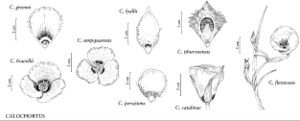Calochortus umpquaensis
Syst. Bot. 14: 12, figs. 1, 2, 3f–j, 4, 5. 1989.
Stems not branching, straight, often scapelike, 2–3 dm, glabrous or glaucous. Leaves: basal solitary, clasping; blade narrowly lanceolate, hairy, adaxially hispid, abaxially glabrous, sometimes glaucous. Inflorescences 1–several-flowered; bracts 2, subopposite, narrowly lanceolate. Flowers erect; perianth open, campanulate; sepals lanceolate-acuminate, ca. 2 cm; petals white to cream, with dark purple-black, pentagonal to lunate blotch, broadly oblong to obovate, 3.5 cm, bearded, adaxial surface typically minutely papillose, margins erose; glands transversely oblong-lunate, slightly depressed, with 0.7–1.4 mm-wide band of short dendritic hairs distally, hairs surrounded by lime-green coloration and purple striations; anthers lanceolate, apex acuminate. Capsules nodding, 3–5.4 cm. Seeds 2.8–3.5 mm, with inflated bulbous crest and hollow lateral ridge. 2n = 20.
Phenology: Flowering late spring–mid summer.
Habitat: Grassland-forest ecotones in serpentine-derived soils
Elevation: 300–500 m
Discussion
Of conservation concern.
Calochortus umpquaensis is known only from Watson and Ace Williams mountains on both sides of the Little River, Douglas County.
Selected References
None.
Lower Taxa
"broad" is not a number."usually longer and broader" is not a number."thicker" is not a number."dm" is not declared as a valid unit of measurement for this property.

